2011.5 PEUGEOT 3008 headlamp
[x] Cancel search: headlampPage 172 of 328
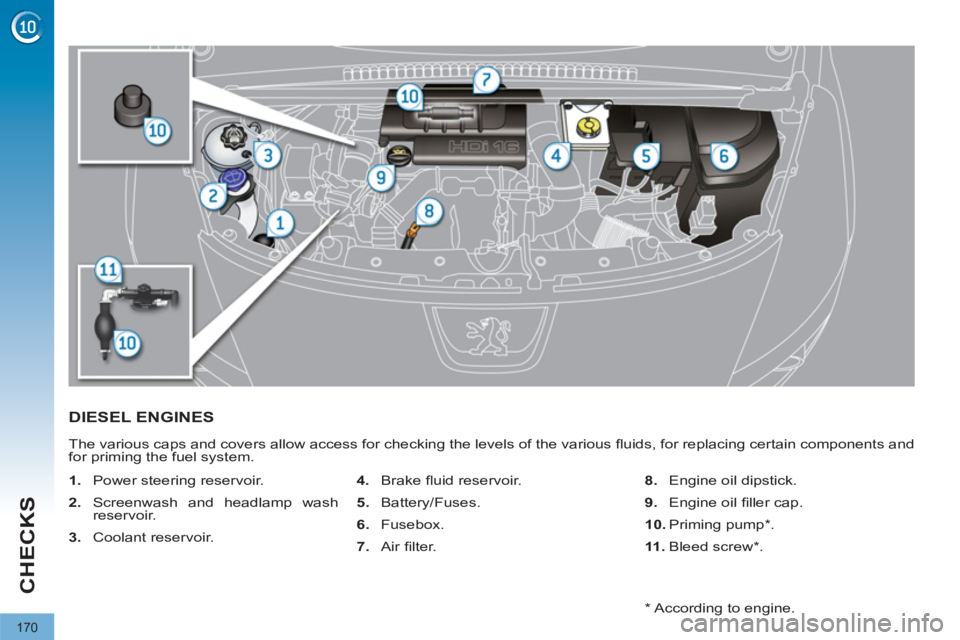
170
CHECKS
DIESEL ENGINES
The various caps and covers allow access for checking the levels of the various fl uids, for replacing certain components and
for priming the fuel system.
1.
Power steering reservoir.
2.
Screenwash and headlamp wash
reservoir.
3.
Coolant reservoir.
4.
Brake fl uid reservoir.
5.
Battery/Fuses.
6.
Fusebox.
7.
Air fi lter.
8.
Engine oil dipstick.
9.
Engine oil fi ller cap.
10.
Priming pump * .
11 .
Bleed screw * .
* According to engine.
Page 173 of 328
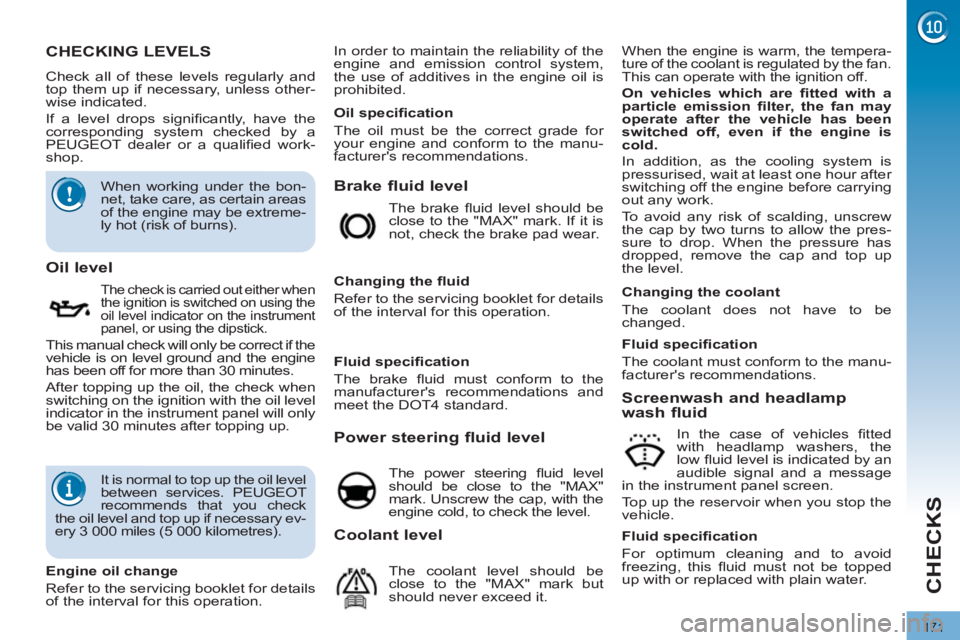
171
CHECKS
CHECKING LEVELS
Check all of these levels regularly and
top them up if necessary, unless other-
wise indicated.
If a level drops signifi cantly, have the
corresponding system checked by a
PEUGEOT dealer or a qualifi ed work-
shop.
Brake fluid level
When the engine is warm, the tempera-
ture of the coolant is regulated by the fan.
This can operate with the ignition off.
On vehicles which are fi tted with a
particle emission fi lter, the fan may
operate after the vehicle has been
switched off, even if the engine is
cold.
In addition, as the cooling system is
pressurised, wait at least one hour after
switching off the engine before carrying
out any work.
To avoid any risk of scalding, unscrew
the cap by two turns to allow the pres-
sure to drop. When the pressure has
dropped, remove the cap and top up
the level.
Oil level
The check is carried out either when
the ignition is switched on using the
oil level indicator on the instrument
panel, or using the dipstick.
This manual check will only be correct if the
vehicle is on level ground and the engine
has been off for more than 30 minutes.
After topping up the oil, the check when
switching on the ignition with the oil level
indicator in the instrument panel will only
be valid 30 minutes after topping up. The brake fl uid level should be
close to the "MAX" mark. If it is
not, check the brake pad wear.
Changing the fl uid
Refer to the servicing booklet for details
of the interval for this operation.
Power steering fluid level
The power steering fl uid level
should be close to the "MAX"
mark. Unscrew the cap, with the
engine cold, to check the level.
Screenwash and headlamp
wash fluid
In the case of vehicles fi tted
with headlamp washers, the
low fl uid level is indicated by an
audible signal and a message
in the instrument panel screen.
Top up the reservoir when you stop the
vehicle.
Engine oil change
Refer to the servicing booklet for details
of the interval for this operation.
Oil specifi cation
The oil must be the correct grade for
your engine and conform to the manu-
facturer's recommendations.
Fluid specifi cation
The brake fl uid must conform to the
manufacturer's recommendations and
meet the DOT4 standard.
Changing the coolant
The coolant does not have to be
changed.
Fluid specifi cation
For optimum cleaning and to avoid
freezing, this fl uid must not be topped
up with or replaced with plain water.
Coolant level
The coolant level should be
close to the "MAX" mark but
should never exceed it.
Fluid specifi cation
The coolant must conform to the manu-
facturer's recommendations.
When working under the bon-
net, take care, as certain areas
of the engine may be extreme-
ly hot (risk of burns).
It is normal to top up the oil level
between services. PEUGEOT
recommends that you check
the oil level and top up if necessary ev-
ery 3 000 miles (5 000 kilometres). In order to maintain the reliability of the
engine and emission control system,
the use of additives in the engine oil is
prohibited.
Page 187 of 328
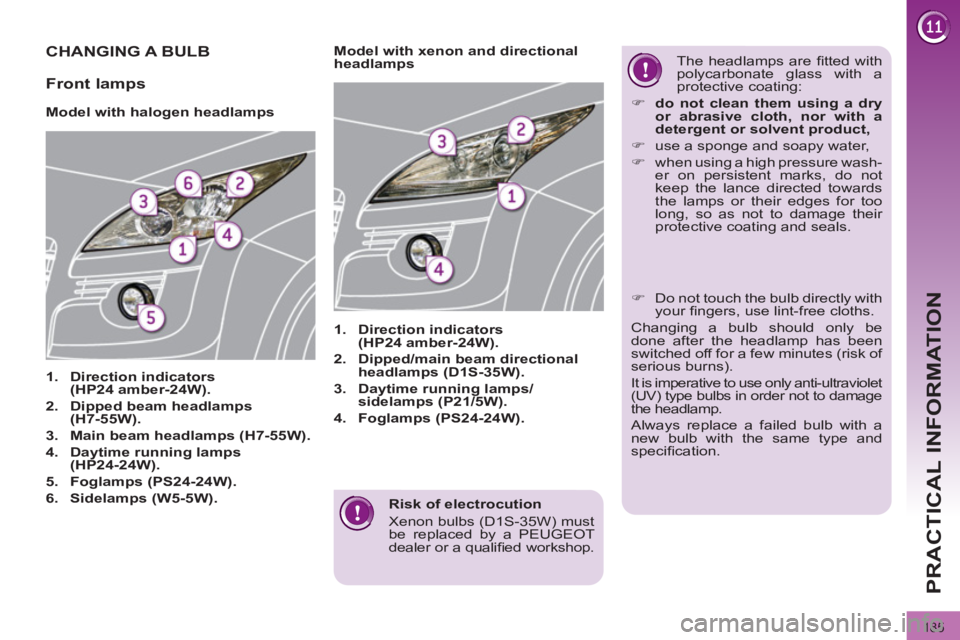
185
PRACTICAL INFORMATION
Risk of electrocution
Xenon bulbs (D1S-35W) must
be replaced by a PEUGEOT
dealer or a qualifi ed workshop.
CHANGING A BULB
Model with halogen headlamps
1.
Direction indicators
(HP24 amber-24W).
2.
Dipped beam headlamps
(H7-55W).
3.
Main beam headlamps (H7-55W).
4.
Daytime running lamps
(HP24-24W).
5.
Foglamps (PS24-24W).
6.
Sidelamps (W5-5W).
1.
Direction indicators
(HP24 amber-24W).
2.
Dipped/main beam directional
headlamps (D1S-35W).
3.
Daytime running lamps/
sidelamps (P21/5W).
4.
Foglamps (PS24-24W).
Model with xenon and directional
headlamps The headlamps are fi tted with
polycarbonate glass with a
protective coating:
�)
do not clean them using a dry
or abrasive cloth, nor with a
detergent or solvent product,
�)
use a sponge and soapy water,
�)
when using a high pressure wash-
er on persistent marks, do not
keep the lance directed towards
the lamps or their edges for too
long, so as not to damage their
protective coating and seals.
Front lamps
�)
Do not touch the bulb directly with
your fi ngers, use lint-free cloths.
Changing a bulb should only be
done after the headlamp has been
switched off for a few minutes (risk of
serious burns).
It is imperative to use only anti-ultraviolet
(UV) type bulbs in order not to damage
the headlamp.
Always replace a failed bulb with a
new bulb with the same type and
specifi cation.
Page 188 of 328
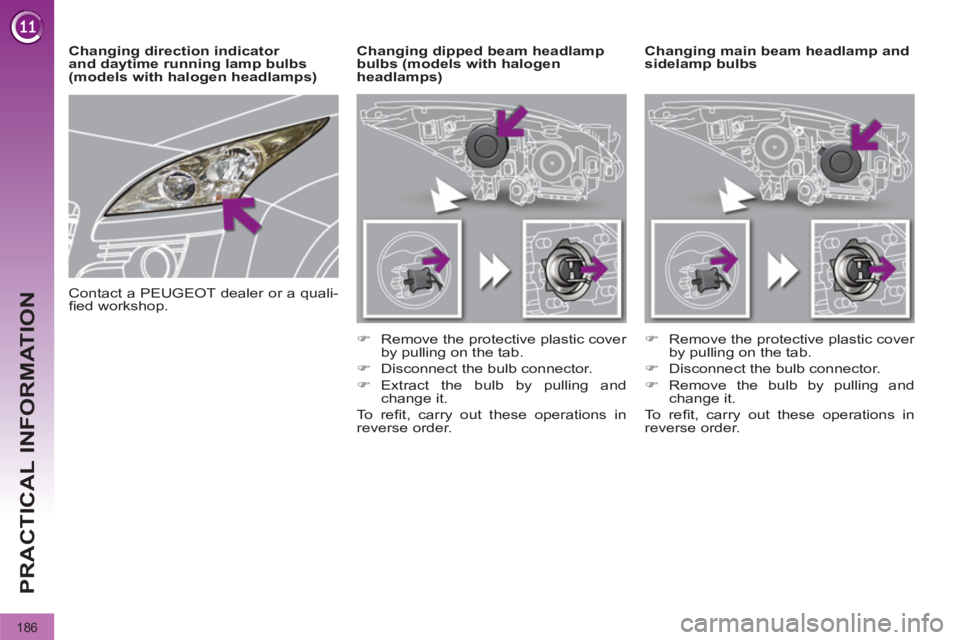
186
PRACTICAL INFORMATION
Changing main beam headlamp and
sidelamp bulbs
Changing dipped beam headlamp
bulbs (models with halogen
headlamps)
�)
Remove the protective plastic cover
by pulling on the tab.
�)
Disconnect the bulb connector.
�)
Extract the bulb by pulling and
change it.
To r efi t, carry out these operations in
reverse order.
�)
Remove the protective plastic cover
by pulling on the tab.
�)
Disconnect the bulb connector.
�)
Remove the bulb by pulling and
change it.
To r efi t, carry out these operations in
reverse order.
Changing direction indicator
and daytime running lamp bulbs
(models with halogen headlamps)
Contact a PEUGEOT dealer or a quali-
fi ed workshop.
Page 189 of 328
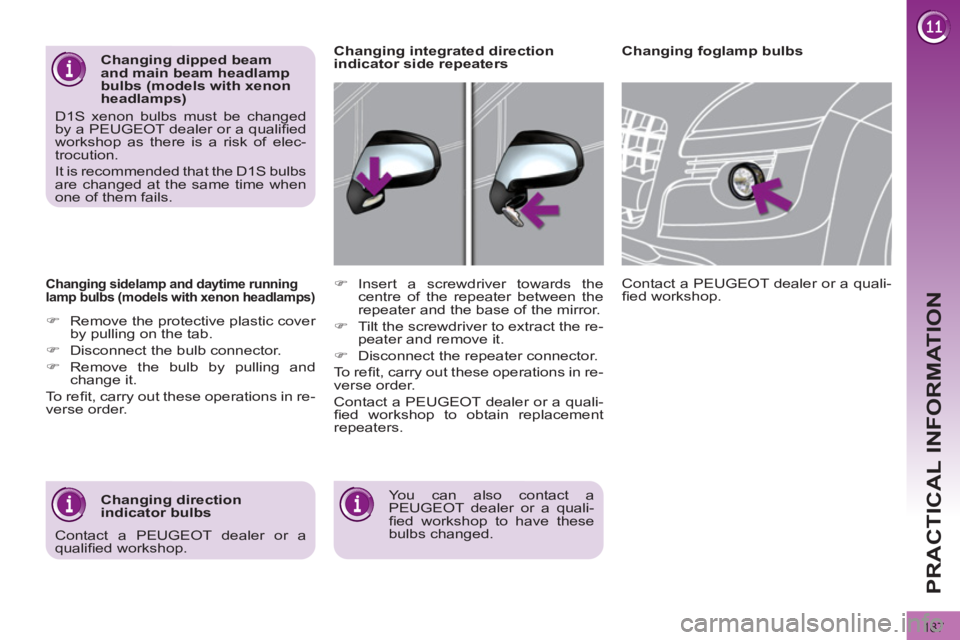
187
PRACTICAL INFORMATION
Changing sidelamp and daytime running
lamp bulbs (models with xenon headlamps)
�)
Remove the protective plastic cover
by pulling on the tab.
�)
Disconnect the bulb connector.
�)
Remove the bulb by pulling and
change it.
To r efi t, carry out these operations in re-
verse order.
Changing foglamp bulbs
You can also contact a
PEUGEOT dealer or a quali-
fi ed workshop to have these
bulbs changed.
Contact a PEUGEOT dealer or a quali-
fi ed workshop.
�)
Insert a screwdriver towards the
centre of the repeater between the
repeater and the base of the mirror.
�)
Tilt the screwdriver to extract the re-
peater and remove it.
�)
Disconnect the repeater connector.
To r efi t, carry out these operations in re-
verse order.
Contact a PEUGEOT dealer or a quali-
fi ed workshop to obtain replacement
repeaters.
Changing integrated direction
indicator side repeaters
Changing direction
indicator bulbs
Changing dipped beam
and main beam headlamp
bulbs (models with xenon
headlamps)
D1S xenon bulbs must be changed
by a PEUGEOT dealer or a qualifi ed
workshop as there is a risk of elec-
trocution.
It is recommended that the D1S bulbs
are changed at the same time when
one of them fails.
Contact a PEUGEOT dealer or a
qualifi ed workshop.
Page 196 of 328

194
PRACTICAL INFORMATION
Engine compartment fuses
The fusebox is placed in the engine
compartment near the battery (left-hand
side).
Access to the fuses
�)
Unclip the cover.
�)
Change the fuse (see corresponding
paragraph).
�)
When you have fi nished, close the
cover carefully to ensure correct
sealing of the fusebox.
Fuse table
Fuse
N°
Rating
(A)
Functions
F1
20
Engine control unit supply, injection pump and EGR
electrovalves (2 litre HDI), injectors (2 litre HDI).
F2
15
Horn.
F3
10
Front/rear wash-wipe.
F4
10
Daytime running lamps.
F5
15
Purge canister, turbine discharge and Turbo
pressure regulation electrovalves (1.6 litre THP),
oil vapour heater (1.6 litre THP), diesel heater
(1.6 litre HDI).
F6
10
Diagnostic socket, directional headlamps, particle
emission fi lter pump (Diesel), Distance alert,
engine coolant level detector, mirror adjustment
control.
F7
10
Power steering control unit, automatic gearbox,
directional headlamps height adjustment motor.
F8
20
Starter motor control.
F9
10
Clutch and brake pedal switches.
F10
30
Engine control unit actuators (petrol: ignition
coils, electrovalves, oxygen sensors, injectors,
heaters, fuel pump, electronic thermostat)
(Diesel: electrovalves, heaters).
F11
40
Air conditioning fan.
Page 197 of 328

195
PRACTICAL INFORMATION
Fuse
N°
Rating
(A)
Functions
F12
30
Windscreen wipers slow/fast speed.
F13
40
Built-in systems interface supply (ignition positive).
F14
30
Air pump.
F15
10
Right-hand main beam headlamp.
F16
10
Left-hand main beam headlamp.
F17
15
Left-hand dipped headlamp.
F18
15
Right-hand dipped headlamp.
F19
15
Oil vapour heater (1.6 litre VTi), Turbo pressure
regulation electrovalve (Diesel), engine coolant
level detector (Diesel).
F20
10
Electronic thermostat, variable timing electrovalves,
Turbo pressure regulation electrovalve (Diesel),
engine coolant level detector (Diesel).
F21
5
Fan assembly relay supply, Valvetronic
relay control (1.6 l VTi 16V), Turbo cooling
(1.6 litre THP), air fl ow sensor (1.6 litre HDI).
Page 198 of 328
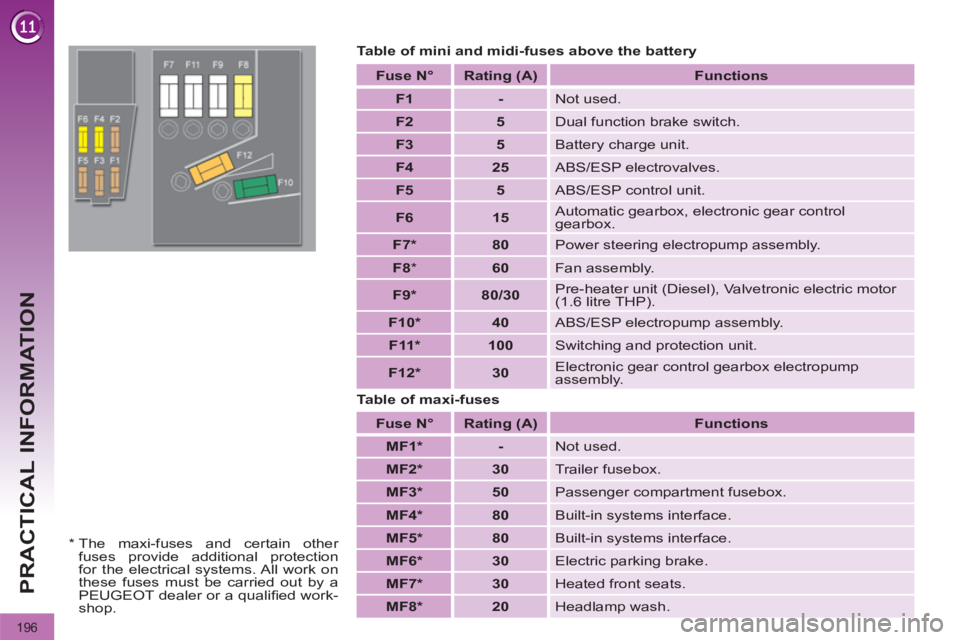
196
PRACTICAL INFORMATION
Table of mini and midi-fuses above the battery
Table of maxi-fuses
Fuse
N°
Rating
(A)
Functions
F1
-
Not used.
F2
5
Dual function brake switch.
F3
5
Battery charge unit.
F4
25
ABS/ESP electrovalves.
F5
5
ABS/ESP control unit.
F6
15
Automatic gearbox, electronic gear control
gearbox.
F7 *
80
Power steering electropump assembly.
F8
*
60
Fan assembly.
F9 *
80/30
Pre-heater unit (Diesel), Valvetronic electric motor
(1.6 litre THP).
F10 *
40
ABS/ESP electropump assembly.
F11 *
100
Switching and protection unit.
F12 *
30
Electronic gear control gearbox electropump
assembly.
Fuse
N°
Rating (A)
Functions
MF1 *
-
Not used.
MF2 *
30
Trailer fusebox.
MF3 *
50
Passenger compartment fusebox.
MF4 *
80
Built-in systems interface.
MF5 *
80
Built-in systems interface.
MF6 *
30
Electric parking brake.
MF7 *
30
Heated front seats.
MF8 *
20
Headlamp wash.
*
The maxi-fuses and certain other
fuses provide additional protection
for the electrical systems. All work on
these fuses must be carried out by a
PEUGEOT dealer or a qualifi ed work-
shop.